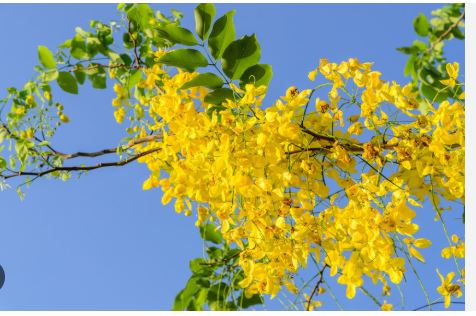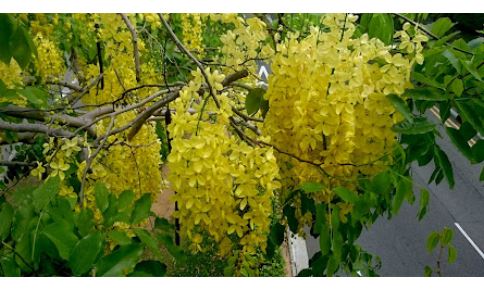
Botanical Classification
The Golden Shower Tree, scientifically known as Cassia fistula, belongs to the Fabaceae family, commonly referred to as the legume, pea, or bean family. It is classified under the genus Cassia, which includes other flowering trees and shrubs, though Cassia fistula is one of the most iconic due to its vibrant blooms. The species name fistula derives from the Latin word for “pipe,” referring to the shape of its long, cylindrical seedpods.
Cassia fistula is also known by synonyms such as Bactrilobium fistula, Cassia excelsa, and Cathartocarpus fistula, reflecting historical taxonomic variations. Unlike some legumes, Cassia fistula is not a nitrogen-fixer, meaning it does not contribute to soil nitrogen levels. Its classification places it in the subfamily Caesalpinioideae, characterized by showy flowers and compound leaves, aligning it with other ornamental legumes like the royal poinciana (Delonix regia). This botanical positioning underscores its tropical and subtropical adaptations, making it a favorite for ornamental gardening.
Native Area and Distribution
Cassia fistula is native to the Indian subcontinent and adjacent regions of Southeast Asia, including southern Pakistan, India, Myanmar, Thailand, and Sri Lanka. Its natural range extends from sea level to elevations of up to 1,300 meters, thriving in deciduous forests, moist subtropical zones, and dry, shallow mountain slopes. The tree has been widely introduced and naturalized across tropical and subtropical regions globally, including the West Indies, Mexico, Ecuador, Belize, Micronesia, East Africa, South Africa, Mauritius, and parts of Australia.
In some areas, such as Queensland, Australia, and parts of the Northern Territory, it is considered an environmental weed due to its ability to escape cultivation and spread via seed dispersal by animals like golden jackals, sloth bears, and monkeys. In 2025, its global distribution continues to expand due to its popularity as an ornamental tree, though careful management is needed in regions where it may become invasive.

History
The Golden Shower Tree has a rich cultural and historical significance, particularly in its native South Asia. Known as Amaltas in Hindi, Kani Konna in Kerala, and Ratchaphruek in Thailand, it holds a sacred place in traditions and is the national tree and flower of Thailand, symbolizing royalty and prosperity. In India, it is the state flower of Kerala and Delhi, and its golden blooms are integral to the Vishu festival, where they are used in the “Vishukkani” display, symbolizing abundance.
The tree is mentioned in ancient Indian epics like the Ramayana and Mahabharata, reflecting its longstanding cultural importance. In Sri Lanka, its durable heartwood was used to construct the “Ehela Kanuwa” at Adam’s Peak, and it is commonly planted in Buddhist temples under the Sinhala name Ehela. Historically, Cassia fistula has been used in Ayurvedic medicine as Aragvadha (“disease killer”), with its fruit pulp employed as a purgative, though modern use requires medical supervision due to toxicity. Its global spread began through colonial trade and ornamental planting, and by 2025, it remains a staple in tropical landscaping, featured in festivals like Thailand’s Royal Flora Ratchaphruek (2006–2007) and on postage stamps in India and Canada.
Identifying Characteristics
Cassia fistula is a medium-sized deciduous or semi-deciduous tree, typically growing to 10–20 meters (33–66 feet) tall, though it can reach up to 18 meters in native environments and is often smaller (5–10 meters) in cultivation. Its trunk is straight, up to 1 meter in diameter, with smooth, pale grey bark when young, turning dark brown and rough with age.
The leaves are alternate, spirally arranged, and pinnately compound, measuring 15–60 cm long, with 3–8 pairs of ovate leaflets (7–21 cm long, 4–9 cm wide), which are vibrant green above and paler beneath. The tree is briefly leafless during flowering, enhancing the visibility of its blooms.
Its flowers are the hallmark feature, appearing in late spring to early summer (April–May in native regions) in long, pendulous racemes (15–65 cm long) of bright yellow, mildly scented blooms, each 4–7 cm across with five petals and seven stamens. These cascading clusters resemble golden garlands, earning the name “Golden Shower.”
The fruit consists of cylindrical, dark brown or black seedpods (30–60 cm long, 1.5–2.5 cm wide), containing toxic seeds within a sweet, blackish pulp. The tree’s oval or rounded canopy, about 4 meters in diameter, adds to to its aesthetic appeal.
Landscape Uses
- Specimen Planting: The tree’s vibrant yellow blooms and graceful canopy make it an ideal focal point in gardens or parks. Its brief leafless period during flowering enhances its dramatic effect, though it may appear coarse when leaves drop.
- Shade Tree: The spreading canopy provides ample shade, suitable for urban spaces, campuses, or residential yards. Its moderate size fits well in medium-sized landscapes.
- Street and Avenue Planting: Cassia fistula is used as a street tree in tropical regions, often alternated with trees like Gulmohar (orange) or Jacaranda (blue) for synchronized colorful displays. It is recommended for roads, railway stations, bus terminals, and riverbanks.
- Parking Lot Islands and Tree Lawns: Its drought and salt tolerance make it suitable for parking lot islands (100–200 sq ft or larger) and tree lawns 4–6 feet wide.
- Biodiversity Enhancement: The flowers attract bees, butterflies (e.g., carpenter bees), and birds, supporting pollinators and local ecosystems.
- Cultural and Spiritual Settings: Planted in temples and used in festivals like Vishu, it adds symbolic value to sacred spaces in India and Sri Lanka.
- Sustainable Landscaping: Its ability to prevent soil erosion and purify air makes it valuable for climate-resilient projects, especially in urban areas.
- Bio-Aesthetic Planning: Its oval growth habit is ideal for framing or screening in educational campuses or large estates.
Cultivation
- Climate: Thrives in USDA Zones 9b–12, preferring warm, subtropical climates with mild winters and hot summers. It tolerates light, brief frosts but is damaged by prolonged cold. In cooler regions like Southern California, growth is slower with winter die-back.
- Sunlight: Requires full sun for optimal growth and abundant flowering. Avoid shady locations, as the tree cannot grow in shade.
- Soil: Prefers well-drained soils, including sandy, loamy, or calcareous soils with a pH of 5.5–8.7. It adapts to various soil types but avoids waterlogged conditions.
Propagation
- Seeds: The primary method, though seeds have a hard coat requiring scarification (abrading with sandpaper or soaking in boiling water overnight) to improve germination. Sow in spring or autumn at 18–22°C for optimal germination. Seeds remain viable for over three years if stored at room temperature with 13% moisture. Seedlings are ready for transplanting after 2–3 years in containers.
- Vegetative Propagation: Cuttings or layering can reduce time to flowering (8–9 years for seed-grown trees). The tree also produces root suckers, aiding natural spread.
- Sowing Tips: In monsoon season (e.g., July–August in India), sow scarified seeds in polybags for the first year, then transplant to the ground in the next monsoon.
Planting
- Spacing: Space trees 5–10 meters apart to accommodate the 4-meter canopy. Young trees may droop, so staking is recommended to develop a uniform crown.
- Watering: Provide regular watering during the establishment phase (first 1–2 years). Once established, the tree is drought-tolerant but benefits from occasional deep watering in dry seasons.
- Fertilization: Apply a balanced fertilizer (e.g., 10-10-10) annually in spring to promote growth and flowering. Avoid over-fertilizing to prevent excessive vegetative growth.
Maintenance
- Pruning: Prune young trees after flowering to shape the canopy and remove drooping branches. Mature trees require minimal pruning, mainly to remove deadwood or maintain aesthetics.
- Pest and Disease Control: Susceptible to mildew and leaf spot in humid conditions, especially late in the growing season. Spray with organic fungicides like neem oil. Caterpillars may defoliate young trees; use insecticides if needed.
- Weed Management: In areas like Queensland, monitor for invasive spread, as seeds remain viable for over a year and are dispersed by animals.
Growth and Flowering
- Growth Rate: Fast in tropical climates (3–4 feet per year), slower in cooler regions like Zone 9b. It takes 8–9 years for seed-grown trees to flower.
- Flowering Season: Blooms in late spring to early summer (April–May in native regions), with leafless branches enhancing the golden display. Flowering is best in hot, dry conditions with distinct summer-winter temperature differences.
Challenges
- Frost Sensitivity: Damaged by temperatures below freezing; protect young trees with frost blankets in cooler climates.
- Toxic Seeds: Seedpods and seeds are poisonous and should be removed in public areas to prevent ingestion by children or pets.
- Invasiveness: Avoid planting in ecologically sensitive areas where it may outcompete native species.